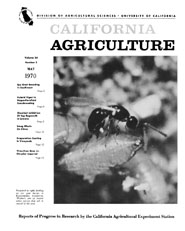


University of California
California Agriculture
|
|||
|
|||

Cover:
Parasitoid to right, feeding on eye gnat larvae, is Eupteromalus hemipterus (Walker), one of several native species that aid in control of the pest.
May 1970
Volume 24, Number 5 |
|||
|
University of California, 1301 S. 46th St., Bldg. 478 Richmond, CA
|